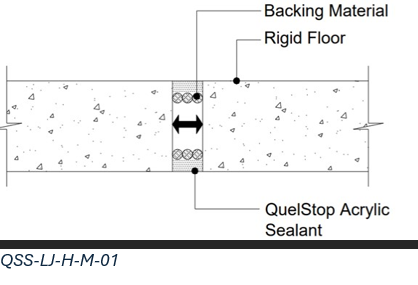We’re often asked whether backing material is required for linear gap seals. The answer is, confusingly, yes and no, depending on the type of backing material. Let us explain why.
Section 7.2.6 of the BS EN 1366-4 fire-resistance test standard for linear gaps states that sealant should generally be used in combination with backing material. Where backing material is used and does not contribute to the fire-resistance performance, only the depth of the sealant is considered the “overall seal depth”.
The seal depth is the sum of the sealant’s thickness and the backing material.
These backing materials come under class B to F (meaning combustible) under EN 13501-1, and include materials such as polystyrene and polyethylene – think swimming pool noodle floats!
Alternatively, backing material of class A1 or A2 (meaning, non-combustible), such as mineral wool, stone wool, rock fibre – whatever you wish to call it – contributes to the overall fire performance of the linear seal. So, in this case, the mineral wool and sealant are accounted for.
‘No’
Typically, at Quelfire, we fire test using PE backing rod, which is a highly combustible material. This type of backing material is purely sacrificial, meaning it does not add to the fire seal or contribute to the fire-resistance performance. Its sole purpose is to ensure the correct depth of the sealant is installed, meaning any material can be used. PE backing rod, PE flat- form roll, newspaper even!
‘Yes’
Introducing rock fibre insulation. Where this is used and referred to on our tested firestopping details, with no mention of PE backing rod, the insulation is used as part of the seal and, thus, needs to be installed as per the requirements. Let’s take tested firestopping details QSS-LJ-H-M-01 and QSS-LJ-H-M-02 as examples. These details are from our solutions library, demonstrating the difference in fire ratings when rock fibre insulation is required.


When using PE backing rod, as shown in detail 01, the up-to-fire rating is EI 60. Yet, where rock fibre insulation is essential, in detail 02, the fire rating significantly increases to EI 240. This means that the seal can withstand fire for a longer period, highlighting the rock fibre insulation’s substantial contribution to the seal.
To conclude, where our test evidence mentions the use of mineral wool, it is critical to install the correct depth and density of the insulation, as well as the depth of the sealant. This ensures the fire seal performs as intended. However, for PE backing rod, the material does not matter as long as you follow the guidance for the depth of the sealant. As always, if you have any questions, please email technical@quelfire.co.uk.
*Up-to-date guidance as of 13/11/2024. Please ensure you always check for any updates in
standards and installation as per regulations and manufacturer’s guidance.

